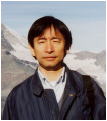
Even if I were like Don Quixote
radix No. 27 : the Kyushu University journal on 15 January 2001
by Shunya Susuki,
entered Department of Architecture at the Kyushu University in 1974
 Even if I were like Don Quixote radix No. 27 : the Kyushu University journal on 15 January 2001 by Shunya Susuki, entered Department of Architecture at the Kyushu University in 1974 |
Hello, everyone.
I'm Shunya Susuki. First of all, let me briefly touch on my background.
I majored in architecture. After finishing the master course of Urban Planning
and Architecture Design at Kyushu University in 1980, I have been working
for Fukuoka City Hall as an architectural engineer. It's already been 20
years - time flies!
 Creating sculpture has been my continuous interest since my university
days. During my studies on architecture design and urban planning at the
university, I came with the following questions: "What is a 'beautiful'
building/city?" "Why do people find it beautiful?" In other
words, I was caught with a proposition on whether there was such thing
as aesthetic evaluation standards for architecture and cities. Hence, I
began to sculpture to verify the existence of aesthetic evaluation standards
in the real world, while also thinking logically by use of Hegel's and
Stalin's dialectics. Creating sculpture has been my continuous interest since my university
days. During my studies on architecture design and urban planning at the
university, I came with the following questions: "What is a 'beautiful'
building/city?" "Why do people find it beautiful?" In other
words, I was caught with a proposition on whether there was such thing
as aesthetic evaluation standards for architecture and cities. Hence, I
began to sculpture to verify the existence of aesthetic evaluation standards
in the real world, while also thinking logically by use of Hegel's and
Stalin's dialectics. The work on the left is a sculpture which I completed in 1982 with cooperation of a foreign student of the Kyushu University medical department as a model. |
I belonged to the Asian Pacific Exposition Association for four years from 1986 to 1989, and dedicated myself to site planning as well as construction of pavilions, and even took part in dismantling them in the end. At that time, the Japanese economy developed exceptionally and was turning into the bubble economy. The value of buildings became very small in comparison with the land value. As a result, unfortunately even new buildings were dismantled for the purpose to sell just the land. This reminded me of the horrible situation after the end of the exposition site when pavilions had to be dismantled after using them for only half a year.
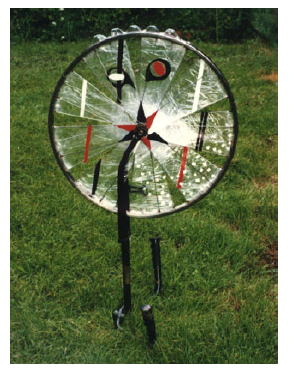 Since those days I began to focus more on environmental problems and educating children on the environment. The work on the left was made in 1993 - it's a "Recycled Art" in which I used the front wheel of a scrapped bicycle as a windmill. As it rotates, hundreds of tiny plastic balls move about inside the plastic egg cartons attached around the wheel and make a sound like waves of the sea. I named it "Message from Nature", and the device was very
popular among the children. Since those days I began to focus more on environmental problems and educating children on the environment. The work on the left was made in 1993 - it's a "Recycled Art" in which I used the front wheel of a scrapped bicycle as a windmill. As it rotates, hundreds of tiny plastic balls move about inside the plastic egg cartons attached around the wheel and make a sound like waves of the sea. I named it "Message from Nature", and the device was very
popular among the children. |
For nearly 30 years I have been living in Toyohama Town, located in the
west of Muromi River in the North side of Mt. Atago. When I first came
to this town, the place was so inconvenient it was called an isolated island
on the mainland. On the other hand, the traffic was light and we could
enjoy the pastoral atmosphere. However, large stores were constructed near
by after a bridge was hung over Muromi River to link to the Asian Pacific
Exposition site in Momochi area, a busy area with tourist attractions such
as Fukuoka Tower and Fukuoka Dome. Toyohama Town was transformed to a traffic
jam area all at once. One morning I found lots of black rain traces on
my white car's bonnet, which brought home to me the seriousness of air
pollution. So I began to think about how to get rid of car exhaust pollution.
It was when I saw an Australian solar car race on TV by chance that I felt
it was my mission to produce a car that runs without petrol.
I started off by looking for a solar panel. I tried to buy it from a manufacturer,
but they regarded me with suspicion, thinking I was a tire kicker and not
really intending to buy it. My coworkers and friends also probably thought
I was joking when I told them about my solar electric car project. In those
days I usually collected the materials for my works from bulk waste junk
yards, which was a gold mine for me. I picked up 4 to 5 disposal bicycles
from those junk yards to utilize them as parts of the car. Both S -1 and
S -2 solar electric cars that I produced during those days were made only
from recycled products collected from a pile of garbage.
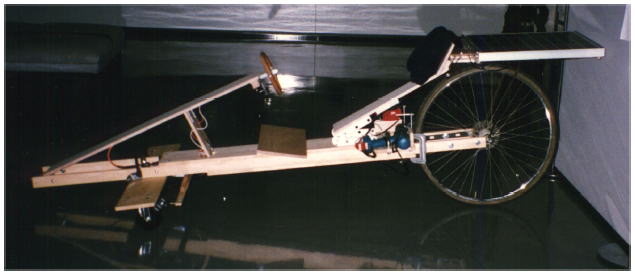 |
| S-1 made in 1993 was an intermediate type between a motorcycle and a car, made of wood to lighten it. |
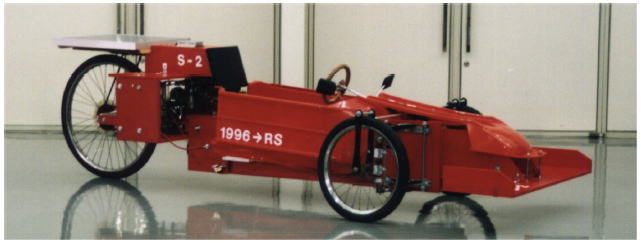 |
| S-2 made in 1996 was made of a wooden chassis covered with plastic grass ski sleds. |
Unfortunately, the bulk waste junk yards disappeared after garbage collection rules changed in 1997. Therefore my car production cost increased as the amount of recycled parts collected from garbage decreased. The third vehicle was made from a brand new wheelchair that I bought myself, on which I attached two motors and one solar roof panel, and was named "solar electric wheelchair" (S -3). The fourth vehicle was made from a brand new electric bicycle, and was named "solar electric car" (S -4). And the fifth vehicle that I am currently working on will mostly be made of newly bought parts, and will be named "four-wheel-drive solar electric car" (S -5). I have spent so much on these productions that, with the amount of money that I spent to create these vehicles in the past ten years I can probably buy a brand new car.
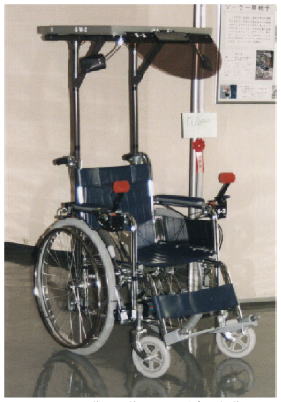 |
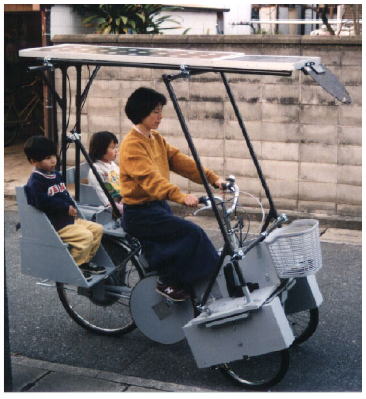 |
|
| S-3 in 1997 can also be operated manually. | S-4 in 1998 has two motors but can also be ridden as a bicycle. |
In the past I read an article in Time magazine that said in the future
people would select electric cars instead of gasoline cars from the viewpoint
of environmental protection. It concluded that the major source of energy
for these cars would not be from solar panels, but from fuel cells. I also
agree to this. However, at present fuel cells are not available for ordinary
people like us. So, I am doing what I can do by myself, which is to produce
electric cars with solar panels. I believe that even an amateur will be
able to influence other people by working to realize his/her ideals. I
think what if each one of us, as an amateur, makes effort to do whatever
he/she can do at his/her extent to improve the environment, it would be
the first step to save the earth. Even though it is like Don Quixote tilting
at windmills.
Last September, I went to Zermatt village, Switzerland, to research on
this car-free resort prohibiting gasoline cars. The purpose of this research
is to analyze the management policies of Zermatt, which is implementing
sustainable development without receiving any subsidy from the Swiss government,
from the viewpoints such as natural resource management, autonomy, finance
and education. I will utilize my analysis to find solutions to the problems
that the local governments in Japan are facing today. Now I am writing
a report to apply the research on Zermatt to "Island City", a
reclaimed island in which environmental problems often come to an issue.
If possible, I would like to talk about this next time.
See you again!
| To "Earth Friendly ! My Works" |